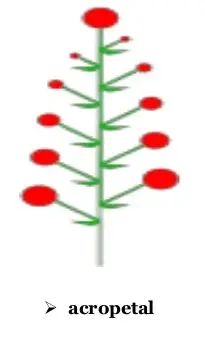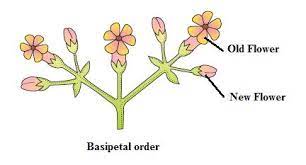Plant growth and development are intricate processes influenced by various factors, including the direction in which growth occurs. Among the patterns observed, acropetal and basipetal orders stand out as fundamental concepts in botany. These terms describe the direction of development in plants, especially in the context of flowering and nutrient transport, but they extend beyond just these functions.
Acropetal order refers to the growth or movement of substances such as hormones or nutrients from the base towards the apex (or tip) of the plant. Conversely, basipetal order describes the movement from the apex towards the base. These directional growth patterns are crucial for the proper physiological and developmental processes in plants, affecting everything from nutrient distribution to the timing of flowering.
Recognizing the importance of these growth patterns, scientists have studied them to optimize agricultural practices and understand environmental effects on plant development. Their findings have not only deepened our understanding of plant biology but also helped in developing more effective agricultural techniques.

Acropetal Order
Definition and Basics
Acropetal order is a term used in botany to describe the sequential development or movement of substances from the base towards the apex (tip) of a plant or its parts. This direction of growth is often observed in the development of flowers, leaves, and the transport of nutrients and hormones crucial for plant growth.
Examples in Nature
Acropetal order can be observed in various natural processes:
- Flowering: In plants like the Snapdragon, flowers develop sequentially from the bottom upwards.
- Leaf growth: New leaves on plants such as ferns appear at the tip and mature downwards.
Key Functions
The key functions of acropetal order include:
- Nutrient distribution: Ensures that nutrients flow towards growing tips, supporting new growth.
- Hormonal regulation: Hormones like auxins that promote growth are transported from the point of synthesis at the base to areas of growth at the tips.
Basipetal Order
Definition and Basics
Basipetal order refers to growth or movement in the opposite direction of acropetal order, i.e., from the apex of the plant towards the base. This pattern is less common but plays critical roles in specific developmental stages of a plant’s life cycle.
Examples in Nature
Instances of basipetal order include:
- Root development: Certain hormones responsible for root growth move downwards.
- Leaf senescence: The aging process of leaves often involves the movement of degradation signals from the tip to the base.
Key Functions
Key functions facilitated by basipetal order are:
- Tissue differentiation: Helps in the differentiation of tissues from mature regions to more basal parts.
- Disease response: Signals concerning pathogen invasion or other stress factors often move basipetally to alert the rest of the plant.
Comparative Analysis
Structural Differences
The structural differences between acropetal and basipetal orders are mainly in the direction and types of substances they transport:
- Acropetal: Primarily involves growth promoters moving upwards.
- Basipetal: Generally involves transport of growth inhibitors or senescence signals moving downwards.
Impact on Plant Health
The direction of growth has significant impacts on plant health:
- Acropetal order supports robust growth and is vital during the early stages of plant development.
- Basipetal order is crucial for the maturation and aging processes, ensuring resources are reallocated efficiently as parts of the plant age.
Role in Reproduction
Reproduction processes also vary:
- Acropetal: Promotes the development of reproductive structures like flowers at the shoot tips.
- Basipetal: Can influence the development of fruiting bodies from the top down.
Factors Influencing Direction
Genetic Factors
Genetic makeup plays a crucial role in determining the dominant growth order:
- Gene expression: Specific genes regulate hormone transport pathways that dictate whether a plant will follow acropetal or basipetal order.
Environmental Influences
Environmental factors also dictate growth direction:
- Light: Direction and intensity can affect hormone production and transport.
- Gravity: Influences how nutrients and hormones move within the plant, often seen in root growth directions.

Applications in Agriculture
Enhancing Crop Yields
In agriculture, understanding and utilizing the principles of acropetal and basipetal orders can significantly enhance crop yields. These growth patterns are manipulated to optimize the distribution of nutrients and growth regulators across the plant system. For example:
- Targeted Fertilizer Application: Applying fertilizers in a manner that mimics natural nutrient movement can improve uptake efficiency.
- Pruning Techniques: Strategic cutting of plant parts to stimulate growth in desired directions and parts.
Breeding Techniques
Plant breeders use knowledge of growth patterns to select and propagate desirable traits:
- Selective Breeding: Choosing plants that naturally exhibit optimal acropetal or basipetal traits for breeding can result in offspring better suited for specific agricultural needs.
- Genetic Modification: Inserting or modifying genes that enhance acropetal nutrient flow can lead to plants with faster growth rates and higher fruit production.
Scientific Studies
Notable Research Findings
Recent studies have provided insights into how directional growth patterns affect plant health and productivity:
- Hormonal Studies: Research has shown how auxins, which are hormones responsible for growth, preferentially move in an acropetal manner to promote new leaf formation and flowering.
- Nutrient Movement Research: Studies have demonstrated how nutrients like phosphorus can follow a basipetal order in certain species, aiding in root development.
Recent Discoveries
The field of plant biology has seen intriguing discoveries related to growth orders:
- Gene Identification: Scientists have identified specific genes that control the directionality of hormone and nutrient transport, opening up possibilities for genetic interventions.
- Environmental Impact: Recent research has highlighted how environmental factors like light and temperature can alter the dominant growth direction, influencing overall plant architecture.
Future Perspectives
Potential Studies
Looking ahead, several potential studies could further elucidate the mechanisms behind acropetal and basipetal orders:
- Climate Adaptation: Investigating how these growth patterns change in response to global climate changes could help develop crops that are more resilient to weather extremes.
- Soil Type Influence: Exploring how different soil types affect the direction of growth and nutrient transport can lead to more efficient farming methods.
Technological Advances
Advances in technology will continue to enhance our understanding and manipulation of plant growth directions:
- Drones and Sensors: Use of drones equipped with sensors to monitor growth patterns and health of crops in real-time.
- Gene Editing Tools: CRISPR and other gene editing tools could be used to alter the genetic factors that determine growth direction, making plants more productive or resilient.
Frequently Asked Questions
What is Acropetal Order?
Acropetal order is a pattern of growth where processes like nutrient transport and hormone signaling occur from the base of the plant or organ towards the tip. This direction supports the developmental gradient seen in young, actively growing parts of the plant.
What is Basipetal Order?
In basipetal order, growth processes or substance movements occur in a direction from the tip of a plant or organ towards the base. This is common in certain types of tissue differentiation and maturation processes.
How Do These Orders Affect Plant Health?
Both acropetal and basipetal orders are essential for the health and development of plants. They influence how nutrients and hormones are distributed throughout the plant, which directly affects growth patterns, flowering, and fruit production.
Can These Growth Patterns Be Altered?
Environmental conditions and genetic factors can influence the dominance of acropetal or basipetal orders in plants. Through selective breeding and biotechnological interventions, scientists can alter these growth patterns to suit specific agricultural needs.
Conclusion
The distinctions between acropetal and basipetal orders not only highlight the complexity of plant biology but also underline the adaptability and intricate regulation within plant systems. As we continue to explore these patterns, the insights gained can lead to advances in agricultural science and plant biology, improving crop yields and sustainability.
Understanding these growth directions also prompts further investigation into how plants interact with their environments and adapt to changes, potentially leading to breakthroughs in how we cultivate not only food crops but also plants used in industry and medicine.

